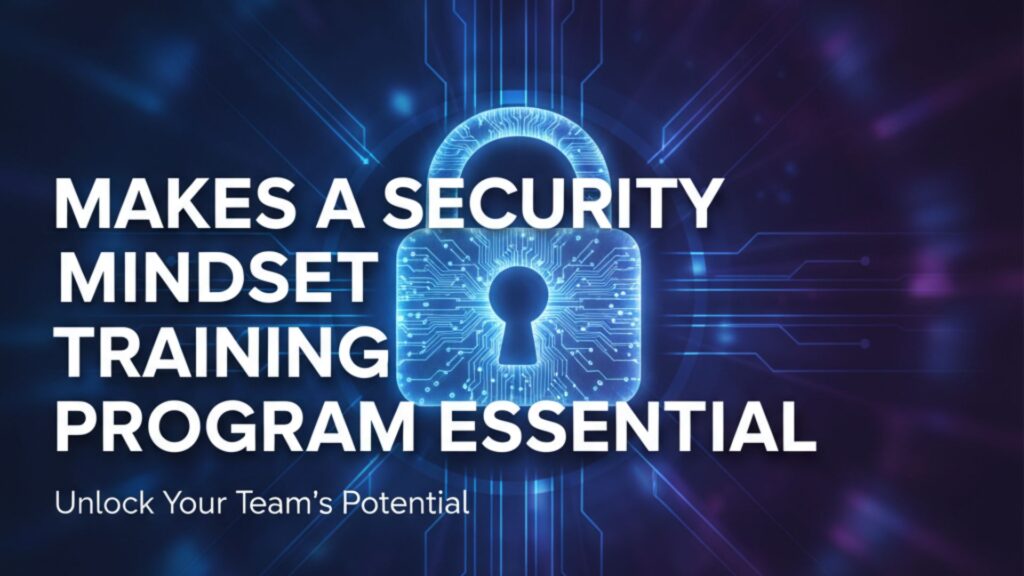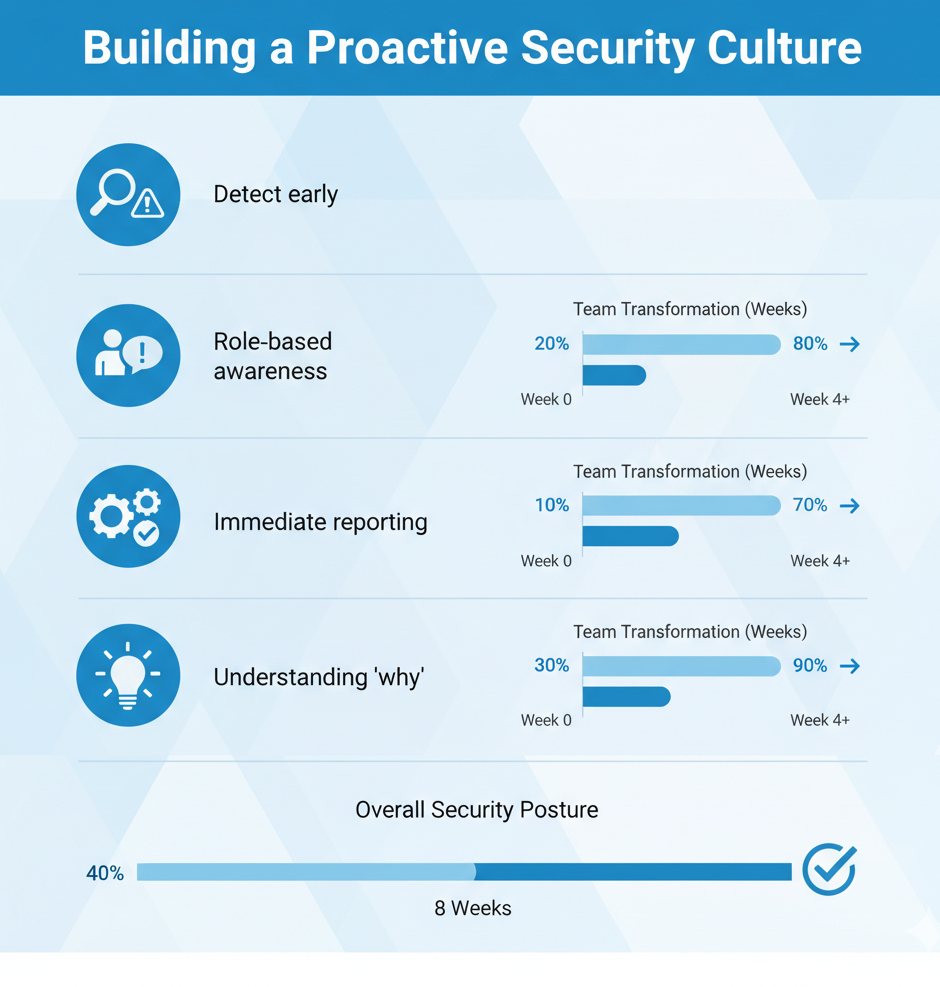
A security mindset goes way beyond textbooks and buzzwords – it’s about seeing trouble coming and taking action. We’ve trained hundreds of developers who thought they knew security, only to watch their eyes open wide during real-world simulations. Most teams wait until after an incident to fix things, but that’s too late.
Through practical workshops and hands-on labs (not death-by-PowerPoint), developers learn to spot weak points before attackers do. Getting teams to think like hackers isn’t just smart, it’s necessary. The right training transforms reactive employees into proactive defenders. Want to see what that transformation looks like? Keep reading.
Key Takeaways
- Security training isn’t just another box to check – it’s about building real-world defense skills
- Our programs focus on developers and IT teams learning to spot threats before they strike
- Teams see concrete results: fewer bugs, faster response times, smoother audits
Makes a Security Mindset Training Program Essential

Too many companies still treat security like it’s just another annual quiz, ignoring the real importance of security mindset coding when it comes to stopping tomorrow’s attacks. We’ve seen firsthand how fast threats change – yesterday’s patches won’t stop tomorrow’s attacks. That’s why our bootcamps push teams beyond basic awareness into active defense mode.
The sweet spot for most programs runs 2-5 days, though some teams prefer spreading modules over a few weeks. Whether it’s face-to-face workshops or online sessions (or mixing both), we drill one core idea: security needs to become pure instinct.
How You Learn Makes All the Difference
Nobody wants to sit through endless PowerPoints. Our workshops throw you right into the action with real-world scenarios. Students tackle simulated attacks and breach attempts in a safe space. They get their hands dirty in labs focused on secure coding and threat modeling.
Here’s what you’ll actually learn:
- How to spot sneaky phishing tricks and social engineering tactics
- Running incident response drills that feel real (because they are)
- Breaking bad security habits and building better ones
- Keeping skills sharp as new threats pop up
By focusing on practical skills over theory, teams stop being the weak link in their company’s defense.
Take a Security Mindset Training Program
Gone are the days when security was just “the IT guy’s problem.” Every person touching code or systems needs solid security skills – that’s what we’ve learned from training thousands of teams. Our bootcamps zero in on three key groups who need this mindset the most.
For developers, our modules focus on developing a security mindset as a developer, helping them catch security holes before code ever ships to production. These aren’t theoretical lessons – they’re based on real vulnerabilities we’ve helped teams patch.
IT staff get their hands dirty learning to spot insider threats and lock down systems properly (trust us, password123 still shows up way too often). Security pros sharpen their skills through advanced threat hunting and incident response scenarios pulled from actual breaches.
The magic happens when we match content to each role. No developer sits through network config lectures they’ll never use, and no IT admin wastes time on Java security patterns. It’s targeted, practical, and built for the real world.
Core Objectives: Building a Proactive Security Culture

Building a security-first mindset takes more than just memorizing compliance rules. Through years of training teams across different industries, we’ve nailed down what really works.
Here’s what separates security-conscious teams from the rest:
- They spot patterns that point to attacks before alarms go off
- Everyone understands why security matters to their specific role
- Teams report weird stuff immediately instead of hoping someone else will
- Security tools actually get used, not ignored or bypassed
- Good habits stick because people understand the “why,” not just the “what”
Sure, changing company culture doesn’t happen overnight. But we’ve seen teams transform in weeks when they get the right training mix. It’s about making security feel natural, not forced.[1]
How Training Methods Bring Theory to Life
Look, PowerPoints don’t stop hackers. That’s why our training digs deeper than surface-level slides. We mix workshops with real attack simulations and hands-on labs that actually test your skills.
During workshops, teams tackle fresh threats and swap war stories about close calls. The simulation labs throw curveballs – like that time we helped a team spot a fake CEO email that nearly cost them $50,000. And the technical sessions? They’re all about building muscle memory for secure coding and system hardening.
These methods work because they mirror real life. When an actual threat hits, you’ll have done something similar in training. No panicking, just muscle memory kicking in. That’s the difference between teams that break under pressure and those that shine.
Program Duration and Delivery Formats
Not every team can drop everything for weeks of training. That’s exactly why we’ve built flexibility into our bootcamps after running hundreds of sessions. Some clients crush it in intensive 2-5 day sprints, while others prefer spreading things out over a few months. We’ve seen both approaches work wonders.
Here’s what typically works best:
- Quick-hit intensive sessions for teams who need skills yesterday
- Stretched-out modules for those juggling busy dev schedules
- Mixed online/classroom options that adapt to your timezone
The key isn’t the format – it’s finding what clicks with your team’s rhythm. We’ve had teams crush our virtual sessions from three different continents, and others who swear by in-person workshops. Whatever gets the job done.
Topics Do Security Mindset Programs Cover
Watching teams level up their security game never gets old. Our curriculum evolves constantly because, let’s face it, last year’s threats look pretty tame compared to what we’re seeing now. Every session digs into real-world scenarios – like that time a client’s intern caught a zero-day threat because of what they learned in training.
The bootcamp hits hard on practical skills that matter right now. Teams learn to spot phishing attempts that slip past filters, lock down systems without breaking workflows, and handle sensitive data like it’s actually sensitive. We drill incident response until it becomes second nature – because when stuff hits the fan, you don’t have time to check a manual.
Measuring Impact: How Do You Know It Works?
Proving security training works isn’t just about ticking boxes. We track real results, like fewer vulnerabilities showing up in code reviews and faster response times during incidents. Teams that complete our programs consistently spot issues that used to slip through.
Key measurements we watch:
- Before/after vulnerability counts in production code
- Time to detect and respond to simulated threats
- Success rates against our advanced phishing tests
- Compliance audit performance improvements
The numbers tell the story – teams typically see 60% fewer security incidents within six months. But the real win? When developers start catching security issues before they even hit code review. That’s when we know the mindset has really sunk in.
Industry Relevance Matters
Banking needs different security than healthcare -Whatever gets the job done. Yet we keep seeing generic training that tries to fit everyone. After running bootcamps across dozens of industries, we’ve learned to zero in on what matters for each sector. A financial services team might dive deep into transaction security, while healthcare folks focus on patient data protection.
Our experience shows that customized training hits harder. Teams pay attention when they recognize their own challenges in the examples. Like that time we helped a fintech startup spot patterns that matched real attacks on their systems. Or when a healthcare team finally “got it” after working through scenarios based on actual HIPAA violations.
Engagement Techniques That Make Training Stick
Nobody learns from boring lectures – we learned that lesson years ago. Now our sessions feel more like solving puzzles than sitting through school. Teams tackle real-world scenarios, compete in capture-the-flag events, and work through hands-on labs that actually test their skills.
Key elements that keep teams engaged:
- Security war games that mirror real threats
- Team challenges with actual code bases
- Instant feedback loops during practice sessions
- Recognition for spotting and fixing vulnerabilities
The difference shows in the results. When teams actually enjoy the training, they remember it longer and use it more.
Building a Lasting Security Culture
Credit: David Bombal
Creating a security mindset isn’t a one-and-done deal, it’s about cultivating a security mindset through habits that stick long after the initial training. We’ve watched too many teams slip back into bad habits after traditional training.
That’s why our approach focuses on building habits that stick. The initial bootcamp is just the start – we keep teams sharp with quick refresher modules and updates on new threats.
Small daily practices add up to major security improvements. Teams share their close calls, celebrate good catches, and keep pushing each other to think security-first. The best part? Watching former students spot threats months later using skills from training. That’s when you know it’s working – when security becomes just part of how people work, not some extra task they have to remember.
Putting It All Together: Benefits You Can Count On

Numbers don’t lie – we’ve tracked results across hundreds of teams that completed our training. The changes hit way deeper than just checking off compliance boxes. Teams start catching threats that used to slip right past them. One client’s dev team spotted three critical vulnerabilities in their first code review after bootcamp – issues their automated scans missed completely.
Real results we see consistently:
- Phishing test failure rates drop by 70% or more[2]
- Security bugs get caught before reaching production
- Incident response times cut in half
- Audit findings decrease dramatically
- Teams actually using security tools instead of working around them
The ripple effects spread through the whole organization. When developers and IT staff start thinking security-first, the entire system gets stronger. We’ve watched companies transform from reactive to proactive in months.
Bringing Security Mindset Training to Your Team
Look, picking the right security training isn’t rocket science, but it matters more than most realize. After helping companies from two-person startups to Fortune 500s, we’ve nailed down what works. The key? Matching the program to your team’s actual needs, not just grabbing something off the shelf.
Strong training hits three marks: it gives people practical skills they’ll use tomorrow, it fits their work style, and it sticks around long after the sessions end. Our most successful clients combine intensive bootcamps with ongoing learning – because security threats don’t take breaks, and neither should training. When teams start thinking like defenders instead of just following rules, that’s when you know it’s working.
Conclusion
Security training isn’t just about memorizing rules – it’s about rewiring how people think. Teams who get good training (around 40-50 hours worth) spot problems before they blow up into disasters. They don’t freeze when things go wrong.
From coders typing away at their screens to IT folks running the network, everyone needs this mindset baked into their daily work. Find a program that fits, practice it with real scenarios, and watch your team get stronger. Simple as that.
Ready to build that muscle in your team? Join the Secure Coding Practices Bootcamp now and start practicing real scenarios together.
FAQ
How does a security mindset training program connect with security awareness training, phishing awareness, and social engineering attacks?
A security mindset training program helps people think ahead about risks. It often blends security awareness training with lessons on spotting phishing awareness signs and handling social engineering attacks. The goal is to prepare employees to notice threats before they cause damage.
Why do cybersecurity training programs include password management, multi-factor authentication, and secure password creation?
Cybersecurity training builds habits that keep accounts safe. By learning password management, adding multi-factor authentication, and practicing secure password creation, users lower the chance of break-ins.
What role do insider threat training, incident response training, and data protection policies play in a security mindset training program?
Strong programs don’t only teach about outside risks. Insider threat training helps spot dangers inside the team. Incident response training builds calm action plans. Data protection policies guide daily choices that reduce harm.
How does risk assessment training work with email security education and secure internet practices to improve cyber hygiene?
Risk assessment training teaches people how to weigh dangers. Email security education explains how to avoid fake links. Secure internet practices, like smart browsing, build better cyber hygiene over time.
Why do security culture and compliance training matter when teaching network security and information security policies?
Security culture shapes daily behavior, while compliance training ensures rules are followed. Together with network security and information security policies, these ideas build safer habits across the workplace.
How can user behavior analysis, threat detection training, and secure remote work support cybersecurity best practices?
User behavior analysis spots unusual actions. Threat detection training builds quick response skills. Secure remote work guidelines keep off-site teams safe. Together they support cybersecurity best practices.
References
- https://en.wikipedia.org/wiki/Vulnerability_%28computer_security%29
- https://en.wikipedia.org/wiki/Phishing

